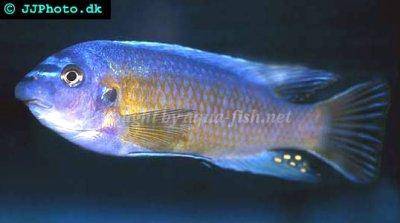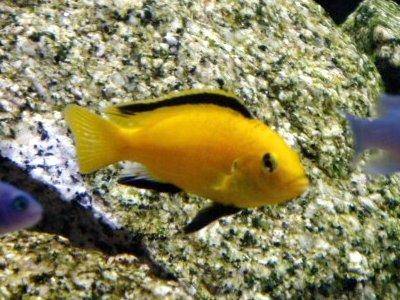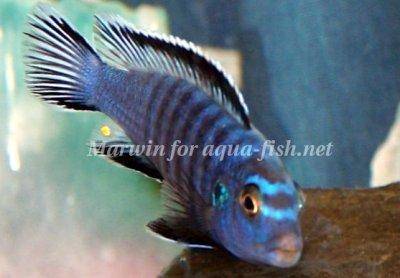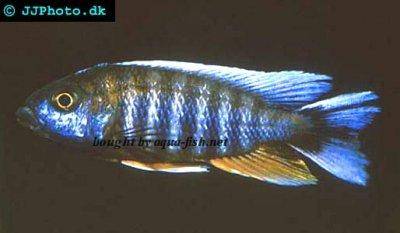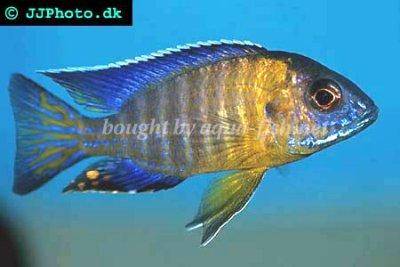Cichlids from lake Malawi - Care, Species, Tips & Forum
Quick links - Answers
Brief Description
This article describes taking care of Malawi cichlids as a whole including breeding, dietary needs and tank set-up. Use a form at the bottom to share experiences regarding keeping Malawi cichlids or simply ask us in case your question isn't answered below yet.
Keeping Malawi cichlids is definitely not for the faint hearted fish keeper. They are all aggressive species, but if kept in the correct conditions can provide hours of entertainment watching go about their daily life.
All of the Malawi species originate from one place, Lake Malawi in Africa. It is one of three rift lakes in Africa, the other two being Lake Victoria and Lake Tanganyika, but the amazing thing is that Lake Malawi is almost entirely inhabited by cichlids, the other two hosts a variety of fish.
There are more than 600 species of cichlids in this lake and they are endemic to it, you will not find them anywhere else in the world. Some keepers will divide the fish into smaller groups, but to me there are only two groups, mbuna and non-mbuna.
Mbuna cichlids
Mbuna cichlids are the most aggressive, they are to be found in the rocky regions of the lake, as there is less space in that region they have to spend more time defending their territories. Mbuna are smaller than the non-mbuna and have some fantastic coloration on their bodies, in their natural habitat their main diet is algae growing on the rocks and any small crustaceans that they can find.
Among the most popular species on mbuna sold are Melanochromis, Cynotilapia, Labidochromis and Pseudotropheus. Out of all of these personal favorite has always been the Yellow Labidochromis (Yellow Labs), their coloration has always shone out for me.
Non-Mbuna cichlids
Non-Mbuna species include Aulonocara, Cyrtocara, Nimbochromis and Lethrinops. These are larger fish than the Mbuna and supposedly less aggressive, I have never found a lot of difference in the aggression myself. These occupy the larger areas of the lake, so defending territories is not so much of an issue but their diet is omnivorous only.
Most of the scientific world agrees that all the endemic species of this lake evolved from one species over a time span of thousands of years, this I find well fascinating as all of the species display uniquely vivid coloration, as well as this there are varieties in some of the body shapes. Keeping Malawi with fish from the other two lakes together has been proven in the past to be a bit of a nightmare, they have different dietary needs and biotope set ups, keeping them in separate tanks has always been the most successful.
It has to be the intense coloration that attracts fish keepers to the African cichlids, the males will provide an awesome display when they are in breeding mode, but a lot of buyers miss out on the fish as the juveniles will often be bland or toned down taking on the females colors, because of this they are often ignored in the pet stores. Another problem that this can cause is trying to sex the fish at a young age, when I have setting up breeding projects I have relied on buying a group of six fish and letting them pair up naturally. As these fish are so aggressive selection of tank members has to be thought out carefully. They do not tolerate their own species trying to invade their territories. Only add to your tank one male from each species, with some of the Malawi fish the females can be as volatile as the males, in this case it can be a matter of trial and error with selecting the fish. Even species that are similar in coloration will provoke aggression, careful planning is the best way to try to control this.
There are a few ways of dealing with the aggression if it occurs, against all fish keeping principles, over stocking the tank will reduce it. The theory behind this is that with high stocking levels the fish will have problems establishing territories. The only downside to this is that the filtration used in the tank must be to a high enough standard to cope with the extra waste load that the fish will produce. Dither fish can be introduced; these are fish that are capable of escaping the aggressors before they are injured. Malawi fish if threatened will kill other tank members to defend their spot. One method I have used is to add any new livestock in the evening when the lights have gone off; prior to this I re-arranged all of the rockwork in the tank so that all of the tank members have to establish new territories at the same time.
Malawi Tank Setup:-
Lake Malawi has little to no vegetation in places, the lake shores are rocky and the substrate is very sandy. This needs to be replicated in your tank. Plenty of rocks should be added to the tank, build them up and create loads of hiding places for the fish. Think of it as a freshwater reef and you will soon know how to create it. Make sure that the rocks are safe for your fish; a rock with jagged edges can cause injuries, only sue the smoothest rocks that you can find. To assist building your rock formation, I found milliput to be an invaluable epoxy to hold the rocks together. Place the rocks in the tank before the substrate, if you are worried about scratching the glass on the tank bottom or wish to spread out the weight of the rock, place some polystyrene pieces underneath them.
The reason for this is that some of the Malawi will burrow into the substrate; if this is done underneath the rocks it can cause a landslide.
I have never added plants to a Malawi set up but if you wish to do so use hard plants like vallisneria, anubia or cryptocorynes. The roots will need protecting from attack, this is done by placing small pieces of rock around the base of the plants, preventing the fish from burrowing into the roots. The plants will not only look decorative but they will also aid the filtration system, removing nitrates from the water.
Substrate can be ordinary sand but I have found crushed coral sand to give the best results in the tank. Malawi fish require hard water with a high pH, the coral sand will act as a buffer to bring your water parameters to the required level.
It doesn’t matter how nicely you set up the tank, the Malawi fish will rearrange everything to suit themselves. This can be very frustrating when the tank looks all nice and neat, then the fish start leaving piles of gravel all over when they have been burrowing or the plants have been uprooted after all of your effort. This is a burden the Malawi keeper has to put up with. The tank size for these fish is usually larger rather than smaller. Most Malawi keepers will use at least a 1000 liter tank, sometimes up to 2000 liters, the bigger the better. With all of the territorial squabbling going on space is limited anyway, give them as much as possible. As a good rockwork system is required, depth of the tank is also important, use the deepest tank you can.
Always remember, the larger tanks will be very heavy when full of rocks and water, make sure that the tank is supported properly on the floor and that the weight is evenly spread.
Plants and rocks in the tank are used as boundaries for the different territories, the fish will respond to any change in their environment, hence the trick of moving rocks when adding fresh livestock.
The pH of the water should be kept at a lower reading of 7.8, and anywhere up to 8.5. Never let it drop below the minimum; if it does there are ways to increase it which I shall write about later. Malawi need hard water, the GH should always be above 10, keeping the KH to at least 8 will ensure more stability of the pH. Temperature of 26 deg F is ideal.
As mentioned earlier in the article, the filtration in a Malawi set up has to be very high. Five times the tank volume is the least amount of water flow per hour that is required. With all of the burrowing and food consumption that is taking place there will be a lot of suspended detritus floating about in the water. This needs to be pulled out by the filters very quickly. I would recommend using two external filters so that the water flow is spread evenly across the tank; the other advantage is that twice the media can be added to them. The externals will need to be cleaned on a regular basis, with all of that detritus floating about, the sponges will block themselves eventually, this will then reduce the water flow.
Dietary needs:-
- One of the biggest problems with Malawi fish is Malawi bloat disease, this is caused by giving the fish the incorrect diet and is very difficult to treat.
- Mbuna require a vegetable diet. Pellets and flake food is alright for these fish, supplement it with some spirulina as well.
- Non Mbuna are omnivores. Blood worms and tubifex should be included in the diet, as well as brine shrimp, but keep varying the diet to prevent the fish from becoming bored with the same food.
Breeding Malawi’s:-
If your tank is kept in optimum conditions with high water quality there should be no problem getting all of the species of Malawi to breed. Feed the fish well and they will spawn on a very regular basis. A lot of the fry will be eaten by the tank inhabitants if the females are left in the main tank, to prevent this if you are interested in breeding properly, the mother fish should be moved to another tank until the fry have reached a juvenile age. Nearly all of the Malawi cichlids are classed as mouth brooders. The female will lay her eggs on either the rocks or on the substrate in the tank, the male will then pass over the eggs and fertilize them. Once the eggs have been fertilized the female will pick them up into her mouth and incubate them until they have hatched out into fry.
After 2 weeks of mouth brooding the female will release the fry into the water, at this stage they are free swimmers, completely able to feed themselves. Most of the females will still protect their fry for several days, she will scoop them into her mouth at any signs of danger, this will also take place in the evening as the fish are getting ready to rest. One advantage of this is that it means the survival rate will be higher than leaving the fry free swimming around the tank.
If the mother has been moved to a separate tank, leave her in their for at least 2 weeks while she is carrying the eggs, trying to net her beforehand can result in the eggs being swallowed or eaten. There is no point offering her any food as she will not eat until the fry are free swimming, it is good practice after the mother and fry have been separated to isolate the mother in her own tank so that she can be given high protein foods to build up her strength again.
Sometimes it is difficult to see if a female is carrying or not, but with experience there are signs that will give it away.
Not so many years ago it was common practice to strip the females of fry so that she could be returned to the males quicker, this would then increase the regularity of the spawning. Nowadays this practice has almost died out and I must admit I was never keen to see this done. When the female was stripped of fry it meant she was netted after the first two weeks of producing the fry and then her mouth was forced open. This would fool the fry into swimming out into the water, as the fry were free swimming, they could be left in a rearing tank to develop. I could understand it being done if the female needed medication or there was a fear of the eggs being eaten but not just to induce extra spawns.
The drawbacks with “stripping” the fish were that the female fish from stripped mothers were more likely to eat their eggs and the males that were produced had duller coloration. Forcing the fry is not a natural way to breed fish; a true fish lover would never indulge in this practice.
Feeding your fry is very easy, newly hatched brine shrimp is readily taken, the liquifry food for egg layers is also suitable if you do not have a brine shrimp hatchery set up. Food should be offered at least 4 times per day initially, as the fry progress, probably two weeks later is adequate, move them onto baby fish food or tetra growth food two to three times per day. A couple of weeks later they should be able to consume the same diet as the parents but if giving them flake or pellets, crush it first.
Water changes are very important for the fry, anything up to 90% per week for the first two weeks, drop this down to 75-80% for the next two weeks. As with all fry that are produced the first 4 weeks are the most important times in their development. After the initial 4 weeks the water changes can be reduced further, right down to 50% per week for the next 4 weeks. At 2 months old the fry are now advanced enough to be either put into your main tank or moved on to other keepers.
Aggression in the Malawi:-
In any aquarium there is a pecking order, even more so in a Malawi tank. Males will not only try to dominate males from the same species but any other species as well. Top of the pecking order will be the alpha male, this fish rules the tank. He has earned the right to chase away all of the other fish, he will have his pick of the females to pair up with. This can cause problems with cross breeding if several species are included in the tank. He will try to mate with any female that takes his fancy. Bottom of the pecking order will be any new additions or any of the weaker fish. In time these fish will work their way up the pecking order till they find their place, but as this is happening there will be a lot of aggression in the tank. Some keepers make the mistake of removing the dominant fish to try to reduce the aggression, but as the alpha fish has gone, another one will take its place, it is best to leave the pecking order as it is.
To make things even more complicated there will be a pecking order with in each of the separate species, and to make matters even worse, this will include the females trying to establish their place.
When it is spawning time the pecking order will change as the males are all trying to become a mate to the females, even more aggression, but once spawning has taken place the original pecking order will be resumed. This is why I mentioned at the start of the article that keeping Malawi is not for the faint hearted fish keepers, and definitely not for novice fish keepers. There may be casualties in the pecking order process but these are usually kept down to a bit of fin nipping or side nudging, but if one of the fish is sick it will not take it long to drop to the bottom of the pecking order and if nothing is done it will not survive. Watching the tank should be done on a daily basis, observe the fish to make sure that they are swimming about in a normal fashion, look out for any signs of diseases as sick fish will need to be removed to a hospital tank for treatment if it is required.
New fish added to the tank start from the bottom, for the first couple of weeks they will try to keep a low profile, probably hiding a lot, if attacked by another fish they will try to swim away out of trouble. However after the initial 2 weeks they will start to fight back, this is to get their place sorted in the hierarchy and is perfectly natural. The same process will occur if a fish has been removed for a period of time for whatever reason. Once re-introduced, it will have to work its way back into the pecking order. As I have mentioned earlier, when adding new fish re-arrange the rockwork to disturb territories, add the newcomers in the evening when the lights are out, the current inhabitants will be at their most sluggish. Sometimes these precautions will still not prevent a new fish from being bullied to the extent that it will not survive, observe the new fish for the first couple of weeks, if it is looking stressed and sickly after that time it will have to be removed.
Buffering your water:-
If you are having problems keeping your pH to the required levels then this probably means that the KH of the water is too low. One of the easiest methods of raising this is to add to your tank water sodium bicarbonate (baking soda), this should be done as slowly as possible. Raising the KH will stabilize the pH of the water to the required level. As the buffer is added, keep testing the water so that you know how much to add.
If low pH is a recurring problem, one of the reasons could be that the water flow is too low. Increasing this or agitating the water surface with a spray bar will release the CO2 from the water quicker, this will then allow more oxygen to be dissolved into the water which will then raise the pH.
Malawi fish can be an interesting group to keep, if the tank is set up properly and there is plenty of swimming space, lots of hiding places for the fish, then the tank will give hours of enjoyment.






